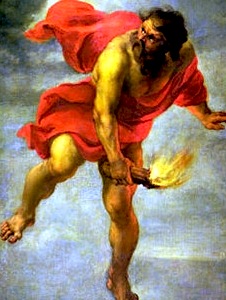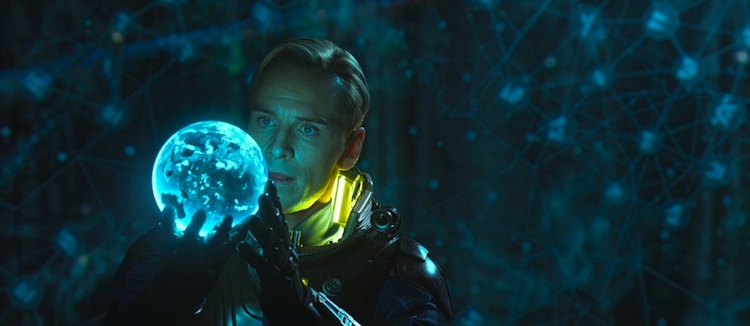[Editor’s Note: the article below and its accompanying slideshow appear today in their entirety on the front page of The Atlantic.]
A guide to the literary, artistic, and political tropes alluded to in Ridley Scott’s sci-fi blockbuster
By Govindini Murty. Ridley Scott’s long-anticipated Prometheus took in $50 million at the weekend box office, and with its heady mixture of sci-fi spectacle and metaphysical speculation is already generating passionate debate.
Set in the year 2093, the film depicts the crewmembers of the spaceship Prometheus as they journey to a distant moon to search for the origins of humanity. The team is led by scientist Dr. Elizabeth Shaw (Noomi Rapace), a Christian believer who has discovered a series of ancient pictograms convincing her that the moon is home to mysterious “Engineers” who created the human species. Shaw is accompanied on her vision quest by a robot with ambiguous intentions played by Michael Fassbender, an icy corporate executive played by Charlize Theron, and a crew of scientists and technicians. Once they arrive on the moon, they find a mysterious dome-shaped structure that contains horrifying forces with the potential to destroy humanity.
The striking images Ridley Scott devises for Prometheus reference everything from Stanley Kubrick’s 2001 to Leonardo Da Vinci’s Vitruvian Man and Mario Bava’s Planet of the Vampires. Scott also expands on the original Alien universe by creating a distinctly English mythology informed by Milton’s Paradise Lost and the symbolic drawings of William Blake.
The following guide unveils the cultural mysteries of Prometheus. (Warning: these slides contain plot spoilers.)

1) The Greek legend of Prometheus
As the spaceship Prometheus approaches the moon LV-223, Peter Weyland, the wealthy businessman funding the venture, addresses the crew in a video. He explains the myth of Prometheus, and says to them mysteriously, “the time has now come for his return.”
In ancient Greek myth Prometheus was a Titan who helped Zeus defeat his father Kronos. Yet after he was cheated by Zeus of his reward, Prometheus defied the gods by stealing fire from Olympus and giving it to humanity. For this crime, Zeus condemned Prometheus to be chained to a rock for all eternity, with an eagle daily tearing out his liver. Aeschylus’ play Prometheus Bound depicts Prometheus as a mad rebel against divine authority. Prometheus barks to the god Hermes: “In a single word, I am the enemy / of all the Gods that gave me ill for good” (975-976), to which Hermes replies: “Your words declare you mad, and mad indeed” (977). This is later inverted in the Romantic poet Shelley’s Prometheus Unbound, which portrays Prometheus as a sympathetic figure and champion of humanity.
There are multiple Prometheus figures in the movie, from the mysterious race of Engineers who appear to have been struck down after using a lethal biotechnology, to Elizabeth Shaw who defies the limits of science to acquire potentially dangerous information about human origins, to Peter Weyland who wishes to gain forbidden knowledge of immortality to make himself equivalent to the gods. Finally, a scene in which Shaw and her fellow scientists attempt to animate the head of one of the Engineers with electricity appears drawn from Mary Shelley’s Frankenstein—subtitled, “The Modern Prometheus.”
>>>TO READ THE REST OF THE ARTICLE AND SEE THE ACCOMPANYING SLIDESHOW, PLEASE VISIT THE ATLANTIC.
Posted on June 11th, 2012 at 3:19pm.

Nice article Govindini. Now how about a straight review of this mess/disappointment of a movie.